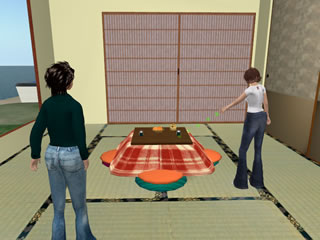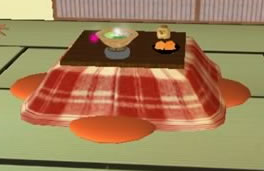| One of the most useful expressions is to ask how to say something in Japanese. You can accomplish this by using the verb いいます "say" as shown below. | ||
|
「table」 は にほんごで なんて いいますか。 | |
| 「テーブル」って いいます。 | ||
| それは おもしろい テーブルですねえ。 | ||
| あ、これは こたつです。 | ||
See Grammar Notes for Dialogue 2.
| 1. | で | by means of, in, with [で marks means or instruments] |
| 2. | (っ)て | [casual quotation marker] |
| 3. | と | [formal quotation marker] |
| 4. | いいます | to say [Xって いいます "(We) call it X"] |
| 5. | おもしろい | [い-Adj] interesting [←→ つまらない "boring"] |
| 6. | ねえ | [sentence particle to seek or express agreement] |
| 7. | こたつ | table equipped with a heater |
1. |
たかい | tall [たかい たてもの: tall building] | [ひくい] | low [ひくい テーブル: low table] | |
| expensive [たかい ほん: expensive book] | やすい | cheap [やすい ほん: cheap book] | |||
2. |
やさしい | easy [やさしい ほん: easy book] | むずかしい | difficult [むずかしい ほん: difficult book]; | |
3. |
おもしろい | interesting [おもしろい ほん: interesting book] | つまらない | boring [つまらない えいが: boring movie] | |
4. |
やさしい | kind, gentle [やさしい ひと : kind, gentle person] | きびしい | strict [きびしい せんせい: strict teacher] | |
5. |
あかるい | bright [あかるい へや: bright room] | [くらい] |
dark [くらい へや: dark room] | |
| cheerful [あかるい ひと: cheerful person] | gloomy [くらい ひと: gloomy person] | ||||
6. |
おいしい | tasty [おいしい ケーキ: tasty cake] | [まずい] | bad tasting [まずい ケーキ: bad tasting cake] | |
7. |
いい | good [いい ペン: good pen; よくない: not good] |
to be introduced later |
[な-adjective] no good | |
8. |
いそがしい | busy [いそがしい しごと: busy job] | to be introduced later | [な-adjective] not busy | |
9. |
かわいい | cute | |||
10. |
[かっこいい] | cool, stylish, nice-looking |

